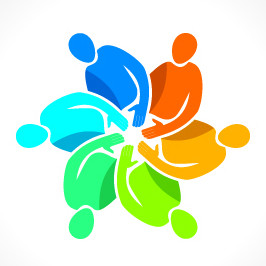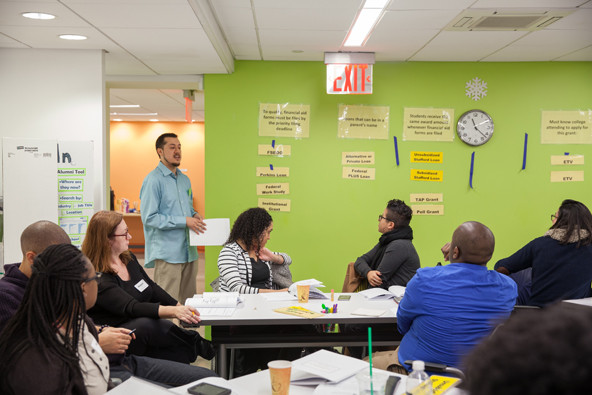Imagine you could speak with all the ninth-graders in New York City’s public schools about their future education and career prospects—64,000 bright, creative, passionate teenagers. Once the excitement passed, a cold reality might set in. Some of these teens will have the opportunity, resources, and support to achieve their dreams, but others will have their dreams deferred.
The Research Alliance for New York City Schools recently found that while about 48 percent of Asian students, 43 percent of White students, and 38 percent of high-income ninth graders earn a college degree in a decade, only 20 percent of Black and Latino students, and 16 percent of ninth graders from neighborhoods in the bottom income quartile do. These statistics, while common across the United States, are startling. They undergird wider and deeper divisions by race and income in employment, lifetime earnings, indicators of civic participation, and individual and family health.

At Goddard Riverside Community Center, located in New York City, and at many nonprofits and community-based organizations across the country, the first response to these gaps in educational attainment has been to create programs to help individuals overcome obstacles, such as providing emergency funds for food or textbooks, on their paths to and through postsecondary education. Goddard Riverside opened the Options Center in 1985 to provide one-on-one support to youth and adults on their road to college, and in 2011 we committed to supporting college students through graduation.
 Educators participating in Options Institute training session. (Image courtesy of Goddard Riverside Community Center - Options Center)
Educators participating in Options Institute training session. (Image courtesy of Goddard Riverside Community Center - Options Center)
For close to 1,000 young people annually, the Options Center offers individual and group educational counseling, college trips, college recruiter visits, connection to academic support, help with financial aid and planning, and scholarships. While our services are open to anyone in New York City, most of our students come from groups that have been traditionally underrepresented in college—young people of color, first-generation college students, undocumented students, low-income students, students with disabilities, foster care students, and young parents.
Our results have been impressive: 85 percent of our high school seniors start college the semester following graduation and 63 percent of our young adults, who are not in school, enroll in college each fall. In 2017, 97 percent of our college freshmen persisted to the end of the year, and outcomes for our first college cohort are shining. For students entering college five years ago, 70 percent of students in four-year programs have earned Bachelor’s degrees, and 47 percent of students starting in two-year programs have earned Associate’s degrees. For students starting an Associates program, 22 percent have earned Bachelor’s degrees.
Along the way, we realized that the Options Center could not reach all of the hundreds of thousands of teenagers and young adults in New York City. There is no way one organization alone can reach every student. But we believed that if every community organization and school had adults equipped with the skills and knowledge needed to support young people—particularly those facing the greatest barriers—to make it to and through college, we could really make a difference in the city.
Instead of widely replicating our programs, in 2005 the Options Center developed a program to train college advisors and school counselors to provide high-quality college advising. Now known as the Options Institute, we train more than 850 individuals annually. Our curriculum was developed based on our direct experience working with students. Trainers are Options Center college access counselors, who know the minute details of the college application process and have a wide range of experience with students in different situations. Along with a citywide training contract with the New York City Department of Education, we have partnerships with nonprofits, such as iMentor, the NYU College Advising Corps, and programs at the City University of New York. Since 2005, we have trained more than 6,600 professionals from more than 600 schools and organizations, and we have begun to see results. Based on a formal evaluation of our training of 1,600 New York City Department of Education staff between 2012 and 2015, conducted by Equal Measure, we have learned that participants are improving their knowledge of the college process, particularly financial aid advising, working with immigrant students, and assessing students for college readiness. The participants are also becoming more equitable in their advising practices. Fifty percent reported working with a broader spectrum of students, and 61 percent reported working with more students than they had before.
Communities across the United States should consider how to better prepare adults to help young people access and succeed in postsecondary education. Many school districts, school counselor education programs, and regional, state, and local nonprofit organizations have already begun to develop and offer college preparation training. Consider these points in thinking about what is right for your community:
- Postsecondary advising requires training in skills and knowledge such as federal, state, and local financial aid; academic support programs; and diversity and STEM recruitment programs, among other topics.
- Each state and locality has its own landscape that is critical to understand and navigate. An advisor in Syracuse, for example, needs to know the State University of New York community college system very well, while an advisor in New York City must become familiar with the City University of New York system.
- A one-size-fits-all approach to working with students on their college and career pathways does not work, and it will likely leave some students behind. In learning about college access, it is critical to understand how many young people may face a web of interrelated obstacles, such as food and housing insecurity, maintaining financial aid, and socio-emotional challenges on the road to postsecondary attainment.
Moving toward true equity on the paths to and through college is a heavy and challenging lift. If we all pull together, and commit to becoming better equipped to support all students, achieving equity will be a sweatless victory. The future of our communities and our country are riding on it. And young people deserve it.
Support SSIR’s coverage of cross-sector solutions to global challenges.
Help us further the reach of innovative ideas. Donate today.
Read more stories by Judith Lorimer & LaKisha N. Williams.

